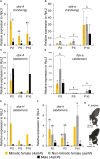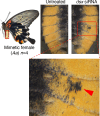doublesex Controls Both Hindwing and Abdominal Mimicry Traits in the Female-Limited Batesian Mimicry of Papilio memnon
- PMID: 38468762
- PMCID: PMC10926503
- DOI: 10.3389/finsc.2022.929518
doublesex Controls Both Hindwing and Abdominal Mimicry Traits in the Female-Limited Batesian Mimicry of Papilio memnon
Abstract
Papilio butterflies are known to possess female-limited Batesian mimicry polymorphisms. In Papilio memnon, females have mimetic and non-mimetic forms, whereas males are monomorphic and non-mimetic. Mimetic females are characterized by color patterns and tails in the hindwing and yellow abdomens. Recently, an analysis of whole-genome sequences has shown that an approximately 160 kb region of chromosome 25 is responsible for mimicry and has high diversity between mimetic (A) and non-mimetic (a) alleles (highly diversified region: HDR). The HDR includes three genes, UXT, doublesex (dsx), and Nach-like, but the functions of these genes are unknown. Here, we investigated the function of dsx, a gene involved in sexual differentiation, which is expected to be functionally important for hindwing and abdominal mimetic traits in P. memnon. Expression analysis by reverse transcription quantitative PCR (RT-qPCR) and RNA sequencing showed that mimetic dsx (dsx-A) was highly expressed in the hindwings in the early pupal stage. In the abdomen, both dsx-A and dsx-a were highly expressed during the early pupal stage. When dsx was knocked down using small interfering RNAs (siRNAs) designed in the common region of dsx-A and dsx-a, a male-like pattern appeared on the hindwings of mimetic and non-mimetic females. Similarly, when dsx was knocked down in the abdomen, the yellow scales characteristic of mimetic females changed to black. Furthermore, when dsx-a was specifically knocked down, the color pattern of the hindwings changed, as in the case of dsx knockdown in non-mimetic females but not mimetic females. These results suggest that dsx-a is involved in color pattern formation on the hindwings of non-mimetic females, whereas dsx-A is involved in hindwing and abdominal mimetic traits. dsx was involved in abdominal and hindwing mimetic traits, but dsx expression patterns in the hindwing and abdomen were different, suggesting that different regulatory mechanisms may exist. Our study is the first to show that the same gene (dsx) regulates both the hindwing and abdominal mimetic traits. This is the first functional analysis of abdominal mimicry in butterflies.
Keywords: Batesian mimicry; Papilio memnon; abdominal mimicry; doublesex (dsx); electroporation-mediated gene knockdown; female-limited polymorphism; supergene; swallowtail butterfly.
Copyright © 2022 Komata, Lin and Fujiwara.
Conflict of interest statement
The authors declare that the research was conducted in the absence of any commercial or financial relationships that could be construed as a potential conflict of interest.
Figures







Similar articles
-
Functional unit of supergene in female-limited Batesian mimicry of Papilio polytes.Genetics. 2023 Feb 9;223(2):iyac177. doi: 10.1093/genetics/iyac177. Genetics. 2023. PMID: 36454671 Free PMC article.
-
Parallel evolution of Batesian mimicry supergene in two Papilio butterflies, P. polytes and P. memnon.Sci Adv. 2018 Apr 18;4(4):eaao5416. doi: 10.1126/sciadv.aao5416. eCollection 2018 Apr. Sci Adv. 2018. PMID: 29675466 Free PMC article.
-
Do juvenile developmental and adult body characteristics differ among genotypes at the doublesex locus that controls female-limited Batesian mimicry polymorphism in Papilio memnon?: A test for the "cost of mimicry" hypothesis.J Insect Physiol. 2018 May-Jun;107:1-6. doi: 10.1016/j.jinsphys.2018.02.001. Epub 2018 Feb 8. J Insect Physiol. 2018. PMID: 29408297
-
Genomic architecture and functional unit of mimicry supergene in female limited Batesian mimic Papilio butterflies.Philos Trans R Soc Lond B Biol Sci. 2022 Aug;377(1856):20210198. doi: 10.1098/rstb.2021.0198. Epub 2022 Jun 13. Philos Trans R Soc Lond B Biol Sci. 2022. PMID: 35694751 Free PMC article. Review.
-
Functional analysis of genes involved in color pattern formation in Lepidoptera.Curr Opin Insect Sci. 2016 Oct;17:16-23. doi: 10.1016/j.cois.2016.05.015. Epub 2016 May 27. Curr Opin Insect Sci. 2016. PMID: 27720069 Review.
Cited by
-
A shared gene but distinct dynamics regulate mimicry polymorphisms in closely related species.bioRxiv [Preprint]. 2025 Mar 3:2025.03.03.641230. doi: 10.1101/2025.03.03.641230. bioRxiv. 2025. PMID: 40093043 Free PMC article. Preprint.
-
Functional unit of supergene in female-limited Batesian mimicry of Papilio polytes.Genetics. 2023 Feb 9;223(2):iyac177. doi: 10.1093/genetics/iyac177. Genetics. 2023. PMID: 36454671 Free PMC article.
-
Single-nucleus transcriptomics of wing sexual dimorphism and scale cell specialization in sulphur butterflies.PLoS Biol. 2025 Jun 18;23(6):e3003233. doi: 10.1371/journal.pbio.3003233. eCollection 2025 Jun. PLoS Biol. 2025. PMID: 40532028 Free PMC article.
References
-
- Bates HW. Contributions to an Insect Fauna of the Amazon Valley (Lepidoptera: Heliconidae). Trans Linn Soc Lond (1862) 23:495–556. doi: 10.1111/j.1096-3642.1860.tb00146.x - DOI
-
- Wallace AR. On the Phenomena of Variation and Geographical Distribution as Illustrated by the Papilionidae of the Malayan Region. Trans Linn Soc (Lond.) (1865) 25:1–71. doi: 10.1111/j.1096-3642.1865.tb00178.x - DOI
-
- Kunte K. Female-Limited Mimetic Polymorphism: A Review of Theories and a Critique of Sexual Selection as Balancing Selection. Anim Behav (2009) 78:1029–36. doi: 10.1016/j.anbehav.2009.08.013 - DOI
-
- Clarke CA, Sheppard PM, Thornton IWB. The Genetics of the Mimetic Butterfly Papilio memnon L. Phil Trans R Soc Lond B (1968) 254:37–89. doi: 10.1098/rstb.1968.0013 - DOI
LinkOut - more resources
Full Text Sources

